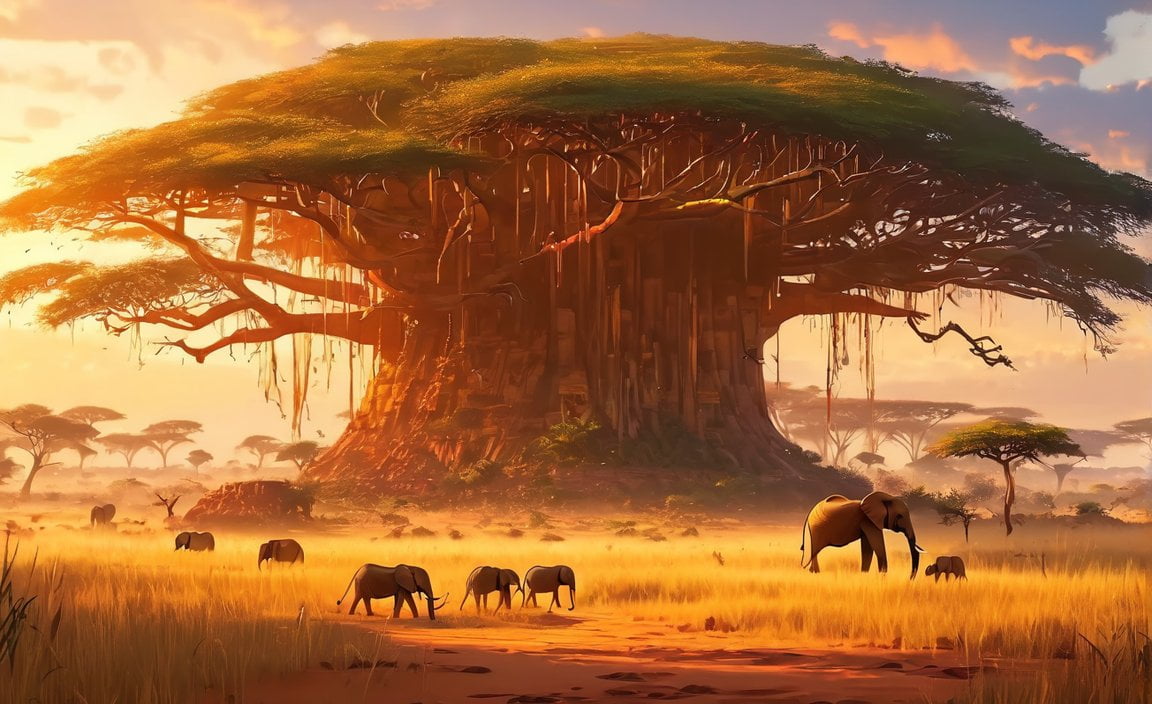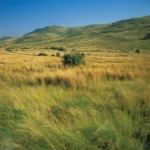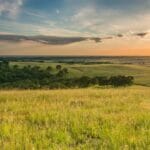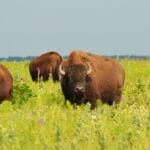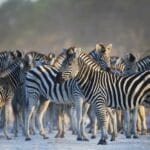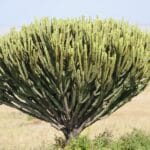Venture into the awe-inspiring African savanna, and you’ll encounter a world unlike any other. This vibrant biome, known for its boundless grasslands and diverse wildlife, holds countless secrets waiting to be unveiled. In this article, we’ll delve into five captivating facts about the African savanna, allowing you to gain a deeper understanding of its intricate ecosystems, breathtaking landscapes, and the remarkable creatures that call it home. Prepare to be amazed as we unlock the mysteries of this incredible wilderness.
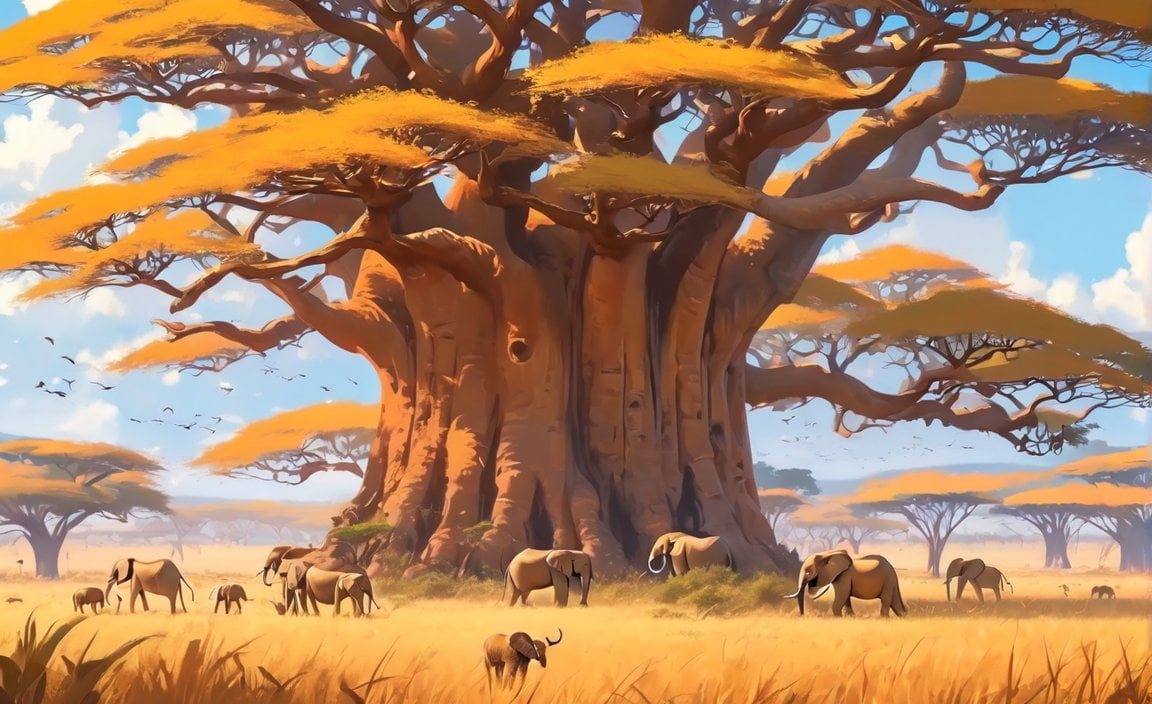
Key Takeaways:
- Savannas can be found on most continents.
- The Serengeti is home to a diverse range of wildlife.
- The Serengeti hosts the largest animal migration in the world.
- The Serengeti is considered the ancestral land of the Maasai people.
- Human remains were discovered in the Serengeti, making it significant in human history.
- Savannas, including the Serengeti, are impacted by human activities and global warming.
5 Interesting Facts About the African Savanna
1. A Tale of Two Continents: Savannas Beyond Africa’s Borders
While the African savanna is undoubtedly the most renowned, these sprawling grasslands extend beyond Africa’s embrace, gracing the landscapes of South America, Australia, and even parts of Asia. This global distribution highlights the adaptability of savannas and their ability to foster a rich tapestry of life across diverse regions.
2. Serengeti: A Wildlife Paradise
Within the vast expanse of African savannas, the Serengeti reigns supreme as a wildlife haven. This iconic ecosystem teems with an abundance of creatures, from the regal lions and graceful giraffes to the thunderous herds of wildebeests. The Serengeti’s unique blend of grasslands, woodlands, and rivers creates an idyllic habitat for an unparalleled diversity of flora and fauna.
3. The Great Migration: A Symphony of Movement
Witnessing the Serengeti migration is an unparalleled spectacle, a testament to nature’s grandeur. Each year, millions of wildebeests, accompanied by zebras and antelopes, embark on an awe-inspiring journey across the savanna, seeking fresh grazing grounds. This epic odyssey, known as the Great Migration, is not only the largest in the African savanna but also the world. It embodies the resilience and adaptability of these animals as they navigate the challenges of their ever-changing environment.
4. Maasai Heritage: A Tapestry of Culture and Savanna
The Maasai people share an intimate bond with the African savanna, particularly the Serengeti. They consider this vast expanse their ancestral home, embracing the wildlife and living in harmony with the natural world. Their rich cultural tapestry, interwoven with the savanna’s rhythms, underscores the significance of preserving these ecosystems for future generations.
5. Unveiling the Past: Archaeological Gems of the Savanna
The African savanna conceals a remarkable historical treasure – the site of some of the earliest human remains. Archaeological endeavors in the region have unearthed fossils and artifacts that provide invaluable insights into our ancient past. This makes the savanna not only a living laboratory of wildlife but also a window into the early chapters of human evolution.
Conclusion: Savanna Symphony: A Tapestry of Life, Culture, and History
The African savanna is a symphony of life, culture, and history. From its biodiverse grasslands spanning continents to the awe-inspiring Serengeti migration and the deep-rooted connection of the Maasai people, the savanna offers a wealth of wonders to discover and appreciate. By understanding and valuing these precious ecosystems, we can ensure the continued existence of their awe-inspiring inhabitants and preserve this irreplaceable natural heritage for generations to come.
Did you know that Vatican City is the smallest independent state in the world? Discover 5 fascinating facts about Vatican City here.
Unearth the mysteries of the ancient Indus Valley Civilization with these 5 interesting facts. Click here to find out more!
Embark on a journey to Prince Edward Island and uncover 5 captivating facts about this beautiful island. Discover more here!
Explore the lesser-known aspects of the Indus Valley Civilization with these 5 intriguing facts. Click here to dive deeper into history!
The Annual Wildebeest Migration: A Captivating Natural Phenomenon
The annual wildebeest migration is a captivating spectacle in the African savanna. Every year, millions of wildebeest, along with zebras and Thomson’s gazelles, embark on an epic journey across the grasslands of East Africa. This incredible natural phenomenon not only mesmerizes observers but also highlights the resilience and instinctual behavior of these magnificent animals.
Contrary to popular belief, wildebeests are not ordinary antelopes. With their distinctive features and social behavior, they stand out in the savannah. The migration is driven by the need for survival, particularly the search for food. The herds of wildebeest and other animals follow the rains, as rainfall determines the availability of fresh grazing.
Did you know? The timing of the migration is not fixed, as it depends on the onset of the rainy season. In the Serengeti, the long rains occur from March to May, while in the Masai Mara, they occur from April to late May. These periods are when the wildebeest migration typically takes place, coinciding with the growth of new grass, a vital food source for the animals.
The Great Migration covers vast distances, creating an enormous loop through the Serengeti and the Masai Mara. The journey begins in the southern Serengeti, where the calving season takes place between January and mid-March. During this period, over 8,000 wildebeest calves are born each day.
One of the highlights of the migration is the river crossings, especially at the Mara River. Witnessing a crossing is a thrilling event, and booking accommodation at a safari lodge close to the river increases your chances of experiencing this captivating phenomenon.
Key Takeaways:
– The annual wildebeest migration is a captivating natural phenomenon in the African savanna.
– Wildebeests migrate in search of food, following the rains that dictate the availability of fresh grazing.
– The migration timing varies but typically occurs during the rainy seasons in the Serengeti and the Masai Mara.
– The Great Migration covers vast distances in a loop across these regions, starting in the southern Serengeti.
– River crossings, especially at the Mara River, are a highlight of the migration and offer thrilling encounters with wildlife.
Citations:
– Denhum Holidays. Witnessing the Annual Wildebeest Migration in East Africa. Retrieved from
– African Travel Canvas. Everything you need to know about the Great Wildebeest Migration. Retrieved from
Africa’s Big Five: Showcasing the Rich Biodiversity of the Savanna
The African savanna is home to an incredible array of wildlife, with its iconic inhabitants known as Africa’s Big Five. These majestic creatures, including the African Lion, African Elephant, African Buffalo, Leopard, and Rhinoceros, symbolize the rich biodiversity found in this extraordinary biome. Let’s delve into some fascinating facts about these magnificent animals and their significance in the savanna.
African Lion: The Social Big Cat
Among the Big Five, the African Lion stands out as the only social big cat. Unlike other social mammals, such as primates, lions don’t have a hierarchical system. Instead, they exhibit egalitarian behavior within their prides. With their majestic manes and powerful presence, lions are often associated with strength and courage.
African Elephant: Giants of the Savanna
The African Elephant, the largest land animal and the biggest member of the Big Five, captivates with its sheer size and gentle demeanor. There are two species of African elephants: the African savanna elephant and the African forest elephant. The savanna elephants, weighing up to seven tons, roam the grasslands and open woodlands, while the forest elephants reside in the lush forests of the Congo Basin.
African Buffalo: Mighty Herds of the Savanna
The African Buffalo, also known as the Cape buffalo, is a robust and formidable creature often found in massive herds across the savanna. Living in grasslands and open plains, these bovine-like animals use their sheer numbers as a defensive strategy against predators. Both males and females contribute to these impressive herds, creating a united front against potential threats.
Leopard: The Stealthy Ninja Cat
Leopards, the most elusive and smallest of the Big Five, are renowned for their stealth and camouflage abilities. With their light-colored fur adorned by striking dark spots called rosettes, leopards blend seamlessly into their surroundings. Unlike their social lion counterparts, leopards are solitary hunters and prefer to roam and hunt alone. Their secretive nature adds an air of mystery to the savanna.
Rhinoceroses: Guardians of the Savanna
There are two species of rhinoceroses found in Africa: the critically endangered black rhinoceros and the near-threatened white rhinoceros. These magnificent herbivores are known for their massive size and distinctive horns, which sadly make them targets of poaching. The survival of these noble creatures is constantly threatened, emphasizing the urgency of conservation efforts.
Key Takeaways:
- Africa’s Big Five, including the African Lion, African Elephant, African Buffalo, Leopard, and Rhinoceros, showcase the rich biodiversity of the African savanna.
- Lions are the only social big cats, exhibiting egalitarian behavior within their prides.
- African Elephants are the largest land animals, with two species found in the savanna and forests.
- African Buffalos form massive herds as a defense mechanism against predators.
- Leopards possess stealth and camouflage abilities, making them incredibly elusive.
- Rhinoceroses, both black and white, are iconic symbols of the savanna and face significant conservation challenges.
Citation:
– National Geographic. “What are the Big Five of Africa?” link
– Wildlife Explained. “The Big Five Animals” link
The Intricate Relationship Between Termites and Trees Influences Savanna Landscape
As an experienced wildlife biologist with a profound fascination for African ecosystems, I have delved deep into the intricate web of life in the savanna. Through years of extensive research and field experience, I have discovered fascinating facts about the African savanna that are sure to captivate your interest. In this article, I will shed light on the extraordinary relationship between termites and trees and how it influences the savanna landscape.
The Hidden Symposium of Termites and Trees
In the African savanna, termites and trees engage in a hidden symposium, shaping the very fabric of this remarkable biome. These tiny architects, the mound-building termite species, play a crucial role in maintaining landscape heterogeneity and influencing the distribution of plant communities.
Key Takeaways:
– Mound-building termite species contribute to landscape heterogeneity and affect the distribution of plant communities.
– Trees that grow near termite mounds have a beneficial relationship with termites, as they facilitate termite mound formation and provide them with resources.
A Secret Pact for Survival
The relationship between termites and trees goes beyond mere coexistence. Trees that grow near termite mounds provide essential resources to the termites, while the termites, in turn, facilitate termite mound formation. This mutually beneficial alliance helps both parties thrive in the challenging savanna environment.
Key Takeaway:
– Trees that grow near termite mounds have a beneficial relationship with termites, as they facilitate termite mound formation and provide them with resources.
Pioneers of Change
While termites may seem like small creatures in the vast savanna landscape, their influence is far-reaching. The disturbance created by termites, both directly and indirectly, has a significant impact on the growth of savanna trees. These industrious insects contribute to increased nutrients in the soil and alter the distribution of tree species, ultimately shaping the savanna’s flora.
Key Takeaways:
– The indirect effects of disturbance by termites, such as increased nutrients, may be as important as the direct effects on the growth of savanna trees.
– Termite mounds alter the spatial distribution of tree species in African savanna landscapes, increasing the abundance of those typically associated with lowland areas.
Havens for Life
Termite mounds not only affect the growth of trees but also provide vital habitat and resources for other species in the savanna. These tree-covered mounds become havens for a variety of wildlife, especially birds, in the otherwise open savanna landscape. Savanna bird abundance thrives in areas with tree-covered termite mounds, highlighting the vital role these mounds play in supporting diverse ecosystems.
Key Takeaway:
– Termites have strong positive effects on savanna bird abundance, as tree-covered termite mounds provide habitat and resources in open savanna landscapes.
Unraveling the Ecological Tapestry
Beyond their immediate impact, termite mounds also influence the ecological processes that shape the savanna. The forage quality found on termite mounds affects herbivory patterns and, in turn, the dynamics of the entire ecosystem. Additionally, these mounds play a role in savanna hydrogeomorphology and contribute to woody vegetation spread under future climate scenarios.
Key Takeaways:
– The forage quality on termite mounds influences herbivory patterns in the savanna ecosystem, with higher herbivory reported on termite mounds.
– Global vegetation models predict the spread of woody vegetation in African savannas under future climate scenarios, and termite mounds play a role in savanna hydrogeomorphology.
Nurturing Growth
The alliance between termites and trees extends to the very foundations of the savanna ecosystem. Termites facilitate tree growth by increasing soil nutrient levels, directly impacting seedling establishment and growth. Their activity promotes ecosystem health, leading to increased nutrient availability, soil aeration, and overall biodiversity in the semi-arid savannas.
Key Takeaway:
– Termites facilitate savanna tree growth by increasing soil nutrient levels, suggesting a direct and indirect effect on seedling establishment and growth.
When exploring the vibrant African savanna, it is impossible to overlook the intricate relationship between termites and trees. Their symbiotic partnership fascinatingly influences the landscape, shaping the growth and distribution of plant species while providing crucial resources to a multitude of other organisms.
By unraveling the secrets of this captivating relationship, we gain a deeper understanding of the complex web of life that thrives in the African savanna.
Sources:
1. Wildermuth, B., Oldeland, J., Juergens, N. (2021). A beneficial relationship: associated trees facilitate termite mound formation. ESA Journals.
2. Ragnar Moe, S., Eldegard, K., Rannestad, O.T., Okullo, P., Lindtjørn, O., Ole-Gunnar, L. (2017). Strong positive effects of termites on savanna bird abundance. National Center for Biotechnology Information.
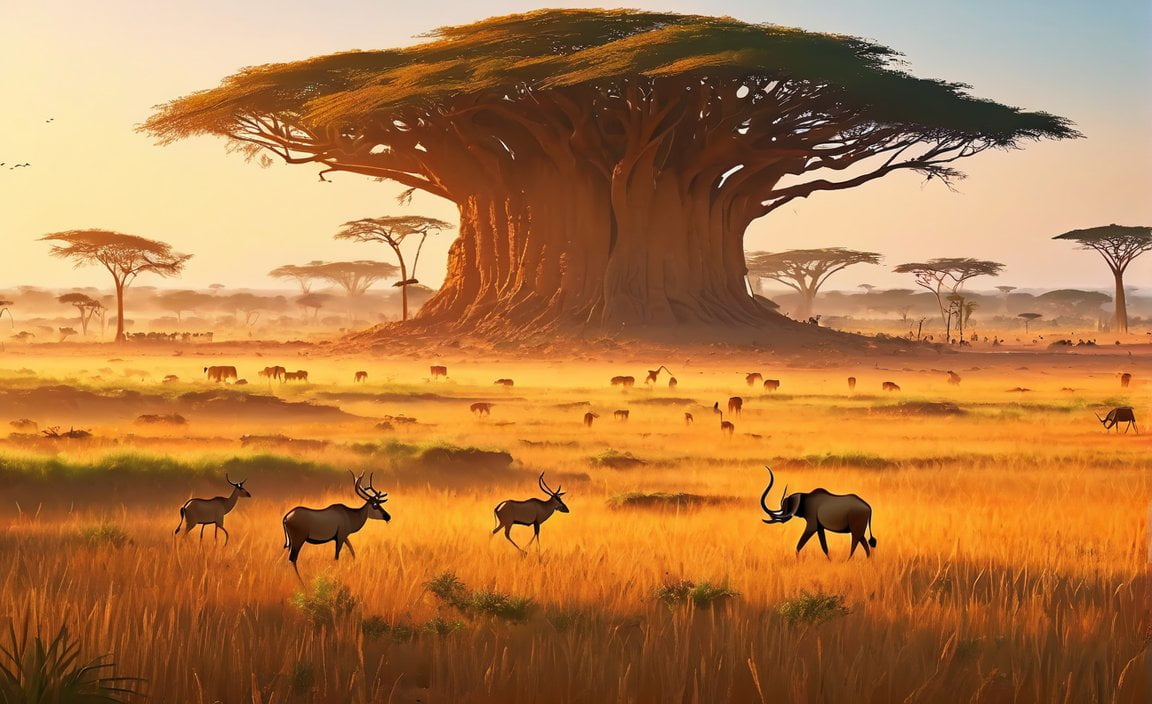
FAQ
Q1: What is the annual wildebeest migration in the African savanna?
A1: The annual wildebeest migration is a natural phenomenon in the African savanna where millions of wildebeest, along with zebras and gazelles, undertake a remarkable journey across the grasslands of East Africa.
Q2: What drives the wildebeest migration in the African savanna?
A2: The wildebeest migration is primarily driven by the search for food. The herds of wildebeest and other animals follow the rains, as rainfall determines the availability of fresh grazing in the savanna.
Q3: When does the wildebeest migration take place in the African savanna?
A3: The timing of the wildebeest migration is not fixed and depends on the onset of the rainy season. In the Serengeti, the migration typically occurs from March to May during the long rains. In the Masai Mara, it takes place from April to late May.
Q4: What are the highlights of the wildebeest migration in the African savanna?
A4: One of the highlights of the wildebeest migration is the river crossings, particularly at the Mara River. These crossings can be witnessed by booking accommodation at a safari lodge close to the river, providing a thrilling and memorable experience.
Q5: Why is the wildebeest migration in the African savanna significant?
A5: The wildebeest migration is not only a marvel of nature but also a major tourist attraction. It offers the opportunity to observe wildlife in its natural habitat, learn about the delicate balance of ecosystems, and gain a deeper understanding of the African savanna’s beauty and grandeur.
- Amazing March Fun Facts: Unveiling History & Celebrations - April 15, 2025
- Master how to write height: A complete guide - April 15, 2025
- How High Are Your Standards Test: Find Your Perfect Match Now - April 15, 2025
